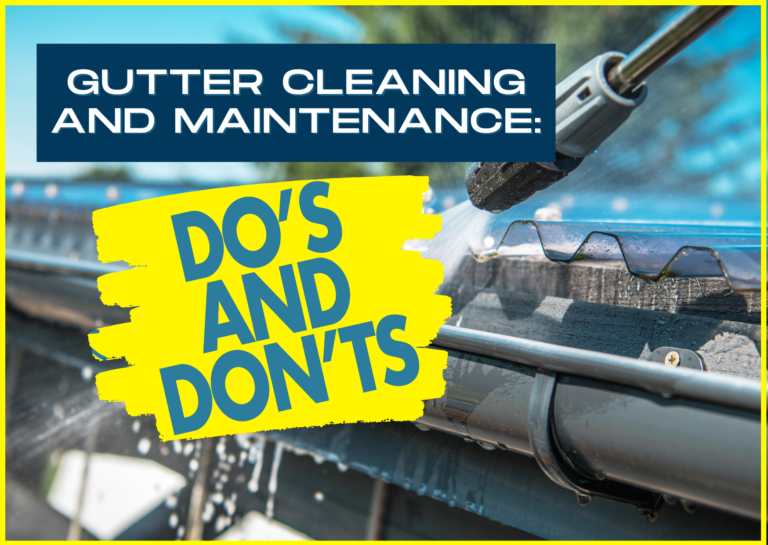According to Home Advisor, the average home maintenance spending has come to $3,192. The national average of gutter care and maintenance cost is between $118 and $225; while gutter repair cost is between $315 and $900 per. Although a gutter cleaning service will make the job easier for you, regularly conducting inspections of your gutters saves you a lot of money in the long run.
Are gutters required by code? The International Residential Code tackles roof drainage in Section R801.3. Though it does not require a gutter system, it notes that builders must build positive drain sites. It specifically mentions that water collected at the roof is required to be drained at least 5ft away from the foundation walls.
When do you think about the condition of your gutter system? How often do you have to clean and maintain gutters? Gutters have one of the most important roles in protecting your home and property. That is to prevent rainwater from pooling up into your home or shifting waters away from the foundation. More than 600 gallons of water would run off the roof of a 1,000 square foot home throughout an inch of rainfall. Without these long and hollow funnels, rain and stormwater can damage your home siding exteriors, and too much of it can erode the soil around your home eventually. What is more, rainwater could end up seeping through your windows and doors if your roof has not enough clearance. When gutters are functioning well, you will protect your home and preserve your yard and even your neighbor’s property.
It’s best to inspect your gutters because they are apt to wear and tear. Knowing the common gutter problems helps you determine how often cleaning and maintenance should be done. What are some gutter troubles that you may encounter when they are not working well?
- Leaks and holes – If you see rainwater falling from the middle of the roof or where it shouldn’t be, then it’s most likely your gutters have sprung a leak. When there is a leak in the gutters system, you will also notice that paint is peeling from the masonry wall, leading to bricks falling off. Another indication of leaks and holes is when your interior walls are becoming damp and cold. This means the water moisture may have run inside, grown molds, and have plaster beginning to break up. Damaged interiors and walls may have a metal substrate break open that would result in more leaks. Besides wear and tear, loosened fasteners are one of the common causes of gutter leaks and holes.
- Incorrect Gutter Slope – Standing water results from when gutters are not properly installed at a slight angle down towards the downspout. The gutter slope, also popularly called the pitch, is essential to the gutter’s entire function. The slope should be situated at least a quarter for every 10 feet of the gutter.
- Clogged Gutter – Another common problem you see with gutters is not draining properly or unable to drain. Gutters can clog up just about anything, from leaves to twigs to seeds and other debris falling from the trees or are blown around in the wind. This defeats the purpose of installing a gutter system. It adds extra weight to the system and can overflow during a downpour.
- Improper Gutter System – The improper installation of your gutters can cause early failure of the gutter. It could be the wrong gutter size, misaligned gutters, or poorly connected joints. These can cause damage to your structure and mean more money is wasted to have it reinstalled.
- Inadequate Downspouts – When downspouts are neglected or incorrectly installed, it causes rainwater to land near the house’s perimeter or even the foundation. Additionally, when downspouts are too narrow, it can slow down the water’s flow, leading to standing water during heavy rains. It can also cause leaks along its length.
- Ice Dam Buildup – One common problem for those living in climates with cold temperatures and regular snowfall is forming an ice dam–the accumulation of ice collected along the rooflines—on the gutter. Icicles are then formed under the gutters. Ice dams can be burdensome as they weigh down gutters and compromise the roof eaves. Because of this, gutters tend to sag and eventually wear down when they can no longer hold the excess weight.
The cost of roof replacement will range from $5,000 to $15,000, not to mention repairing damaged walls and paint. Now that you know some of the gutter defects to watch out for, let’s go over how to help you clean and maintain your gutters.
Keeping your gutter clean and properly maintained can be worthwhile, time-saving, and puts your mind at ease. Although these tasks may sound dreadful and are not your favorite thing to do, we’ve come up with a list of some do’s and don’ts to help you do them the right way. Keep your gutters functional by:
Do’s
Start with checking electrical lines on your roof.
Work safely and securely on your gutter system. The first thing to do before climbing up to do the work is to check for power line hazards. Some homes are built with electrical lines that are installed too close to the gutter. You can contact your utility company to help you set up an insulation blanket. You should also make sure that the power line cables do not have their wire insulations rubbed off. If you notice this, call a licensed professional electrical contractor to repair them. If you do happen to be around electrical cables of any kind, do not use ladders that conduct electricity. Fiberglass ladders are best when it comes to working around electrical.
Set up your space.
You may lay a piece of sheet or plastic tarp on the ground away from your ladder, so falling debris and other particles lay directly on the tarp. This saves you so much time tidying up the area after you’ve cleaned the gutter. So, you can collect the garbage in one place and easily dispose of them in the bin. I use a five gallon bucket, tied down to the top run, using a hook from a tie gown strap without the ratchet. You should only fill the bucket half to two thirds full if there is lots of moisture, or wet sand. because the moisture makes it a lot heavier to handle when going up and down the ladder.
Wear rubber-soled shoes.
When it’s necessary to climb up and walk on the roof, wearing rubber-soled shoes can prevent slip-and-fall injury. Rubber-soled shoes keep you safe in case your ladder rungs or steps are wet. It reduces the possibility of slipping. It is best to have a boot with a hill that will catch the rungs if your foot does slip.
Wear protective goggles.
You might think you are just dealing with leaves and twigs. Your gutter can be filled with roof sand, stones, animal feces, pollen particles, and dust that may carry bacteria. You do not want them in your eyes. It’s important to put safety first and wear protective goggles. Make sure your goggles snugly fit your face, including angles in the front, bottom, sides, and top. Better safe than sorry, and set sand does not feel good in your eye!
Use a sturdy ladder on flat, solid ground.
While a four-legged stepladder would be all right for a single-story house, an extension ladder is needed if you have a double story or more. Suppose your ground is uneven, secure leg levelers to allow your ladders to stand still. You may also attach an accessory like a ladder stabilizer. Its wide arms and slip-resistant rubber pad grips your house wall adding stability to your ladder. You should also check your ladder’s rating system to see its weight capacity. A ladder with a pail shelf on its opposite is a great way to keep your hands from holding the bucket. The bucket will be used for collecting the debris you will have scooped out. So, your ladder should be able to hold at least a five-gallon bucket. You can also secure your bucket with a lanyard or a rope.
Make sure that there are no obstructions to your gutters and downspouts.
To prevent leakage, make sure that gutters are clear of debris and build-up that may clog free flow. A gutter scoop allows you to pick up debris easily, even compacted ones, without hurting or puncturing your gutter surfaces. This tool also secures your hands and prevent you from touching sharp objects in the gutter. To flush the debris, you can fit a hose with a high-pressure nozzle toward the downspout. Closely monitor the debris to ensure they all go down the downspout onto the ground. Check out your nearest hardware to get these tools.
Use a drum auger to push out debris.
After trying to flush out all the debris, there will be times when water does not drain smoothly through the drainpipes. You can use a handheld drum auger or a drain snake to withdraw debris from the bottom. Read the manual and instructions carefully to prevent the auger from destroying the PVC pipes.
Clean gutters twice a year or quarterly.
This is especially true for traditional gutters. Homeowners should clean their gutters once in spring and autumn, right before winter comes. Now, if you have pine trees near your home, it’s best to clean your gutters quarterly.
Install gutter extensions.
Installing a gutter extension to the bottom of the downspout can greatly help expel water to a specific spot, usually away from the foundation. They control water coming out of the downspout instead of just splashing out everywhere. This can protect your basement from flooding during heavy rains and the accumulation of water on your rooftop.
Check for pitched gutters.
A proper gutter slope’s basic rule is to set at least a quarter of an inch every ten (10) feet. Gutters must be pitched toward the nearest downspout. For instance, if your gutter measures 30 feet, the gutter’s end should be positioned ¾ of an inch than the other end. You can do this by attaching strings to your gutter’s highest point and the other end of your downspout. To know the distance, measure the length between the two strings. Take the string at the end of the downspout and lower it to the calculated slope. Reattach string and put marks to determine where your gutter lines should follow.
Check for leaks.
It’s easy to spot big cracks and holes in your gutter, but small leaks and tiny holes can be tricky. A way to detect them is to run water through the system and watch out for water that trickles out of the gutter. Check and take note of parts that require repair or replacement. Even if you have set up gutter cleaning schedules, it’s always a good idea to check your gutter for leaks from time to time.
Inspect all the connections within the gutter system.
To keep your home safe and dry, a routine check on all the connections in the gutter system is advised. Every connection needs to be sealed, whether it be the endcaps, drop outlets, or splices. Fasteners, leader pipes, and downspouts should be properly connected to provide open movement of water. Check the condition of joints and look for damages from animals or storm.
Caulk with gutter sealant
After locating all the gutter seams that need repair, the next thing to do is wash or clean the area. It’s best to dry up any moisture on it, too. This is to ensure there are no grimes or debris left. After you’ve cleaned the area, apply, or caulk the sealant along the seams or holes. If you want an added protection from future leaks, you can apply more sealant around the original fitting of the downspout along the gutter.
Use Gutter Guards
Leaves, twigs, branches, and other debris that enter the gutter can get it blocked up, causing water overflow. For you to save more time in cleaning your gutters the next time, it’s best to invest in gutter guards. Gutter guards cover the gutter and are designed to filter debris from the water. Although these won’t eliminate debris into your gutter, gutter guards help minimize the accumulation of leaves and debris, avoid animal or insect from breeding and prevent premature rust and corrosion in your gutters.
Ask a buddy to help you.
It’s not a bad idea to ask a helper when cleaning and maintaining your gutters. They can give a hand in case you drop something, need to move the tarp, keep your ladder stable, or an extra set of eyes to keep a close watch. Why not get someone to help you out and keep you from going up and down the ladder.
Don’ts
Lean the ladder on the gutter.
Leaning the ladder on the gutter will scratch the surface of your gutter and could give a slippery rail to your ladder. You can use a standoff or stabilizer to put the ladder in place and away from the gutter.
Lean the ladder in front of a door.
Unless it is blocked or locked, you should never position your ladder in front of a door as someone might open it and accidentally knock the ladder off.
Reach too far to your side.
When using an extension ladder, you should not risk falls by leaning too far away on your side. Maintain your balance by keeping your hips square to the ladder. It is a lot safer to move or drag the ladder than put it in one position.
Clean gutters in wet or windy conditions.
Don’t risk falling from your ladder. Work on your gutters in suitable weather conditions. When rains and winds are too strong, you risk falling off when the ladder gets blown away.
Do not use a leaf blower.
Leaf blowers have been known to help get leaves and debris off the gutters, but you wouldn’t like what happens when you use them. They are great for sweeping up the ground and not the gutters above. When used, the force of leaf blowers tends to push leaves and debris up under the bottom of your eaves space. This would lead to a much more difficult cleaning task in the future. Roof eaves with dried leaves and debris are a fire risk. Power washer and gutter scoops are more recommendable than using leaf blowers to clear debris from your gutters.
Put off cleaning gutters for the next season.
Clean your gutters now or pay the consequences later. Do not wait until the gutter overflows before cleaning it. Clogging, blockages, and decomposed materials can develop quickly so. It’s a whole lot better to clean your gutters on time. Then again, during summer, leaves and other dry debris can be a fire hazard, and in winter, they cause water damage.
Ignore the possibility of downspouts freezing in winter.
Although ice does not fall directly into the downspouts, ice accumulation is common if there is clogging. The elbows of your downspout are vulnerable to this situation. The extra weight of ice may cause cracks and leaks into your gutter system. Bear in mind what they say about an ounce of prevention. Prevent frozen gutter by having self-regulating cables or heating system installed. This system melts snow and ice before they even form into mounds of blockages. You can also wrap your downspouts with heat tape. Still, it all boils down to maintaining your downspouts for winter.
Ignore small issues
Even with a short period, small issues in your gutter system can turn into serious problems such as mold, deteriorating framing and sheathing, damaged insulation systems and ceilings. An example would be a disregard for downspouts draining too close to the foundation. Downspouts need to be several feet away from the foundation. Otherwise, it will dump water directly into your house. You should not ignore these small issues. Fix them as soon as they occur so there will be no more detrimental consequences in the future.








One thought on “Gutter Cleaning and Maintenance: The Dos and Don’ts”
Comments are closed.